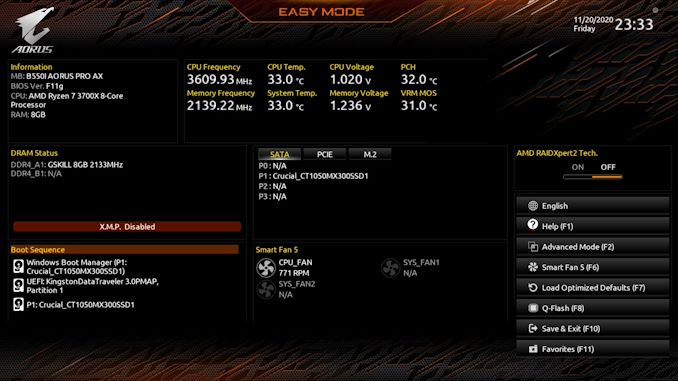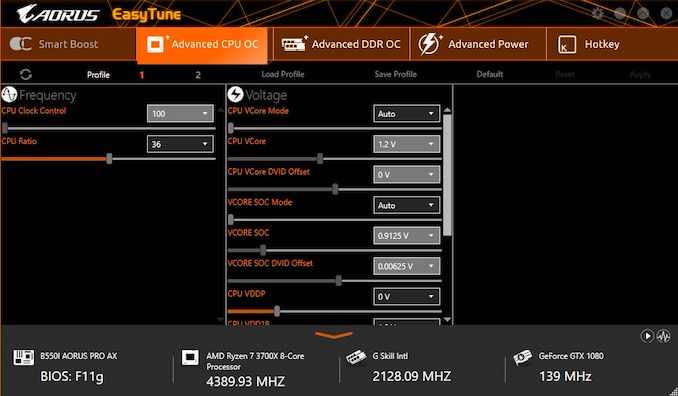The GIGABYTE B550I Aorus Pro AX Motherboard Review: All The Small Things
by Gavin Bonshor on December 7, 2020 10:00 AM ESTBIOS
Unspringsingly, GIGABYTE's B550 firmware is practically identical to its X570 models, as we've seen previously in our GIGABYTE X570 I Aorus Pro WIFI review. The GIGABYTE UEFI firmware for its AMD 500 series Aorus branded models follows a distinct black and orange theme, with white text and orange highlighting. Looking at the BIOS layout, GIGABYTE has split the firmware into two modes, easy mode for the beginner and advanced for the more experienced user.
Focusing on the Easy mode screen, which is the default screen when POSTing for the first time, displays basic yet relevant information about hardware installed. Towards the top is a list of information, including the motherboard model, the BIOS version (F11g for our test), and the processor and amount of memory installed. Users can select between the different types of devices to check if the hardware is installed correctly, including SATA, PCIe, and M.2 devices, as well as a basic list of Smart 5 fan details for the board's three 4-pin fan headers. Along the right-hand side, users can select between different functions, including the advanced mode by pressing the F2 key, load up the Smart Fan 5 tuning utility by pressing F6, and the board's integrated Q-Flash utility for updating the board's firmware by pressing the F8 key.
The rest of the board's firmware focuses on the Advanced mode, which can be done by pressing the F2 key. This allows users to select between various BIOS functions, including the Tweaker sections where all of the board's CPU, memory, and integrated graphics overclocking can be done. Users can adjust CPU frequency, the base clock (BCLK), CPU VCore, among many other voltage settings, including CPU VDDP and DRAM termination voltages. This is also where users can enable XMP profiles at the click of a button or customize memory profiles further for performance tweakers. It should be noted the sweet spot for Ryzen 3000 processors is DDR4-3600, with an Infinity Fabric clock speed of 1800 MHz.
Overall, GIGABYTE's Aorus UEFI firmware keeps things simple with the basic mode, with a basic looking, but the bountiful and endless list of configurable variables, most of which can be found in the Tweaker section. The firmware itself is responsive and offers users from both the novice and advanced spectrums plenty of options to work with.
Software
All of the major motherboard vendors have equally impressive software packages, with various functions to use all of the boards primarily features. GIGABYTE includes plenty with the B550I Aorus Pro AX model, including the EasyTune software designed to allow users to overclock within Windows, the RGB Fusion 2.0 software to control the board's RGB capabilities, and the System Information Viewer (SIV). The SIV software allows users to access the Smart Fan 5 utility within Windows and allows for system alerts for over-voltage and various temperatures.
The most prominent piece of software bundled with the GIGABYTE is the Aorus Easy Tune software. This allows users to overclock the memory and CPU within Windows, with plenty of voltage options and important CPU ratio and memory ratio settings. We still recommend all of the overclocking is done within the BIOS, but overclocking software has come a long way over the last decade, and Easy Tune is quite intuitive.
Unfortunately, GIGABYTE doesn't include any audio software within the bundle, and users looking to make customizations will need to download the Realtek Control Panel directly from the Microsoft Store. Focusing on what is actually there, the bundle offers plenty of customizability. This includes the Fusion 2.0 RGB software for those adding additional RGB LED strips and the Realtek Gaming LAN manager for traffic shaping when used with the RTL8125 2.5 GbE port on the rear panel. It's not the most comprehensive software suite we've seen over the years, but it's more than enough for a sub $200 model aiming at the mid-range.
























76 Comments
View All Comments
meacupla - Tuesday, December 8, 2020 - link
yup, that's exactly what happens.The only remaining fix I could think of was replacing the soldered in BIOS chips
star-affinity - Tuesday, December 15, 2020 - link
Just wanted to say that my problems was resolved with a new power supply! So now the Gigabyte motherboard is working fine again, believe it or not. :)duploxxx - Tuesday, December 8, 2020 - link
not to mention cold boot - bios resets - unable to save q-fan profiles etc...I was very impressed by the x370 although it lacked some easy visual design.
The x570 gigabyte is not worth the money, would stay away from it as much as possible.
I also own an Asrock B450 board, a much better bios layout.
Dug - Tuesday, December 8, 2020 - link
Strange. I have Gigabyte going back to p965 with no issue.No issue with my x570 aorus pro wifi like you describe either, like thousands of others.
kkilobyte - Tuesday, December 8, 2020 - link
I - and others - have zero idea on what is triggering the issue. There is clearly something fishy going on with the power distribution on the Aorus X570, but so far, it was not possible to pinpoint the origin of it. ErP, USB load, PSU, DisplayPort, Sleep modes, RAM modules all have been suspected, but none of those elements led to anything conclusive. There is a +20 pages thread on hardforum.com about it. I tried to probe the issue with my scope, but it happens completely randomly; so far, it happened to me 3 times in about 8 months, and last time it happened, I was in a hurry and couldn't test.Doing a CMOS reset through the jumper doesn't solve the issue; it could thus mean that it is not a cmos-ram corruption, but a more fundamental electrical issue. My best bet is that somehow a power spike at shutdown is sometimes high enough to wrongly toggle a signal line that 'locks' one of the components kept alive by the battery.
Finding the solution would require identifying the components that are kept powered by the cmos battery; without precise motherboard schematics, however, that's going to be difficult; even if it gets identified, I don't see how it would be solved without some sort of hardware hacking.
My personal solution is to design an arduino-based circuit that plugs on the battery connector of the motherboard, and allows a 'reset' through a front panel button. It's less than ideal, but that's better than having to open the case and remove my gfx card just to get the battery out.
mkarwin - Tuesday, December 15, 2020 - link
Well if CMOS reset does not fix the issue there's either a failing BIOS chip or circuitry throughout the board's layers... Theoretically one could pinpoint the issue by replacing the BIOS chip...BTW. I honestly wonder why they haven't thought of putting BIOS(es) on microSD cards, some of those smaller ones would be dirt cheap nowadays and capacituous enough to handle modern UEFI BIOSes - easy to remove/replace/reflash, could maybe improve the consumer attitude towards the issue if it is related to BIOS chips...
hansip87 - Monday, December 7, 2020 - link
What i don't understand with AMD mini ITX board is how few are their USB ports available at the back. one of the reasons why i chose going intel route was that there is this cheap Asrock Z490 itx board with 8 USB ports at the back. Sure it;s not the only factor but why can't any of AMD ITX boards do the same?romrunning - Monday, December 7, 2020 - link
Well, you can always just get a plug-in USB hub if you need more. I think the mfgs don't add as many USB ports mostly as a cost-savings.mkarwin - Tuesday, December 15, 2020 - link
Seems quite odd considering they are still asking more ($) for less (size & features)... It's not like they're running out of space on I/O shield, there's no integrated massive cooling openings in most cases, so adding eg. 4 extra even 2.0 USB ports would be more beneficial than having 3 display outputs for the integrated Radeon solutions... I could see a future where more integrated display outputs is beneficial - if they allow adding those server/compute accelerators without display outputs so that they could pass through the display to those board integrated ports. Otherwise, I think maybe 1 HDMI is enough. Especially if you can use said HDMI to pass through audio from the integrated card as well...jeremyshaw - Monday, December 7, 2020 - link
Probably the massive AMD AM4 keep out area. It doesn't really matter for mATX and ATX, but for mITX, every mm^2 matters. But every B550 ITX board is flawed in some way.ASUS hates rear I/O altogether, ASRock ditches the S/PDIF and doesn't have all that many USB ports (still more than ASUS). Gigabyte's never head of USB-C headers, and MSI gets all of that right, but has a proprietary backplate.
X570 came out a year earlier and is worse in many ways. ASUS is pricing their top end board for people without sense, and all of the X570 mITX boards from all other vendors lack the USB-C header. All of them are also 1GbE only, which seems like a waste for such a fast platform. ASRock has TB3, but only one M.2 slot, and very few USB ports.
In the end, I've held off upgrading my old AB350 Fata1ity ITX, since nothing is really appealing w.r.t. upgrading (not to mention almost twice the price!). Ryzen 5000 might force my hand, but I'd still rather not "upgrade" to boards that are very flawed (IMO) vs their Intel counterparts.
On Intel, all is not perfect, but there are more "perfect" boards that don't have these same issues.